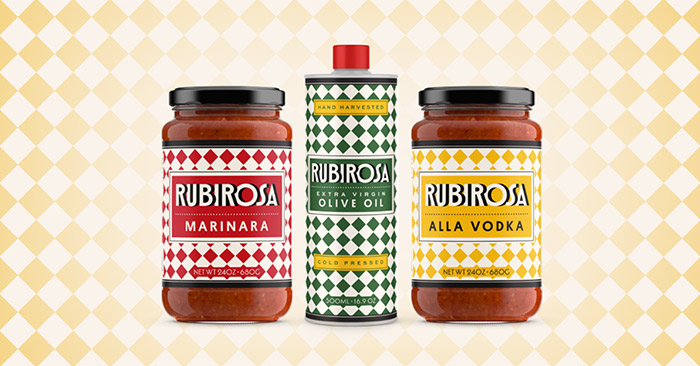Rubirosa Takes Its Sauce To Shelves With CPG Line

New York-based Italian restaurant Rubirosa is exploring new revenue streams, announcing the company will make its first foray into CPG with the launch of a line of pantry staples.
The family restaurant was opened 13-years ago by AJ Pappalardo and manager Bari Musacchio, and is best known for its thin crust pizzas and signature pastas. After Pappalardo’s passing in 2015, his sister, Maria, became co-owner with Musacchio. Located on Mulberry Street in New York City’s Nolita Neighborhood, Rubirosa was named one of the best pizza restaurants in the U.S. by Food & Wine magazine in 2018.
The Rubirosa team focused on three pantry staples for its first product launches: Marinara Sauce, Vodka Sauce and Extra Virgin Olive Oil. The marinara sauce features a blend of plum and pear tomatoes and was inspired by the family’s legacy Staten Island pizzeria mother sauce. The unfiltered, Extra Virgin Olive Oil, used in the restaurant’s own kitchen, originates from a fourth generation farm in Italy. More products are slated to debut in 2023.
“Rubirosa’s success is attributed to the Pappalardo family’s time-honored recipes, as well as being a presence in the restaurant to develop that warm, family-style Rubirosa experience we think of today,” said Musacchio in an email to NOSH. “Our guests truly value a ‘unique sense of place’ at 235 Mulberry Street due to our cozy, historic location in NYC, and instead of expanding the number of locations, we’re bringing Rubirosa to your kitchen.”
The CPG line dubbed Rubirosa at Home, is a part of the original Rubirosa parent company and will launch direct-to-consumer on Oct. 5 and later expand into retail. According to Musacchio, Rubirosa at Home is currently in discussion with regional and national distributors as it seeks to achieve national distribution in the next year.
Recognizing that it can be difficult to scale from a small-batch restaurant process to large, professional manufacturing , the Rubirosa team brought on R&D firm Rodeo CPG to assist with operations. The restaurant currently works with a local co-packer for both of its sauces.
Rubirosa at Home is not the only CPG brand with roots in a famed Italian restaurant. In 1992, New York City’s cult restaurant Rao’s began selling its homemade pasta sauces, one of the first premium brands in the category with national distribution. Since then, the portfolio has grown to include dry pasta, jarred soups, frozen entrees and, most recently, frozen pizzas.
In 2017, the sauce brand, which was then led by CPG veteran Eric Skae, was acquired by Sovos brands. During a conference earlier this month, the now Colorado-based brand reported that Rao’s will surpass $500 million in sales by the end of the third quarter, up from $60 million in sales at the time of its acquisition, with 50% of sales coming from sauces alone. Christopher Hall, Sovos CFO, added that he expects the brand to surpass $1 billion in sales in the next few years.
New York City restaurant Carbone also launched its tomato sauces as a CPG line last year, with the support of Skae, who now is CEO of that venture.
The cooking and pasta sauce category have heated up in recent years in part due to the COVID-19 pandemic. Though consumers first stayed home out of necessity, many have continued to keep up cooking habits with research firm NPG group reporting that in-home dinners are expected to remain at a heightened level through 2024.
For restaurants, which have struggled with labor issues, reduced revenues from private events and uneven booking levels, packaged foods have served as a means of diversifying their revenue streams.
But with Rao’s sauce usually at a $7 to $8.99 MSRP and Carbone retailing for between $9 to $10, Rubirosa’s $13.99 price point will establish a new high for the category. How that will perform as consumers look to tighten their pocketbooks during a possible recession remains to be seen. According to research firm Mindsight, a recent study found 55% of consumers say value has become more important when buying groceries.
Still, the restaurant sees potential in the new venture.
“We are excited that there is a lot of energy in the space and are looking forward to seeing how home cooks utilize our products,” said Musacchio.

















